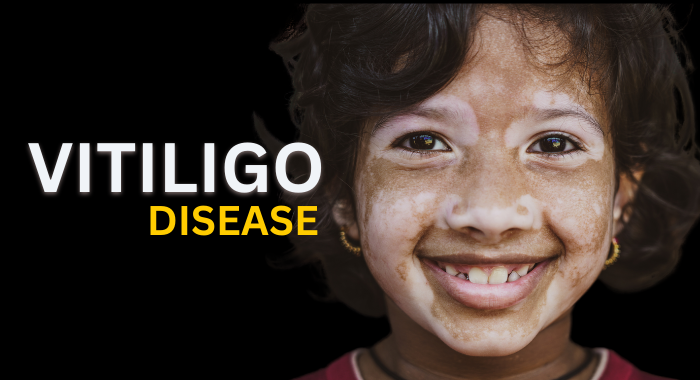What is vitiligo Disease?
Vitiligo disease is a condition that causes loss of pigment/color of skin in several patches. Vitiligo may affect any body part. The white spot’s size will increase exponentially with time, which means the patch’s size will increase as time passes. These white vitiligo spots start on the feet, hands, forearms, and face. In this condition, melanocytes tend to die or fail to release melanin (the pigment responsible for skin tone). By the time the white patches will start becoming more bright. Vitiligo is not a lethal or contagious disease hence, treatment is not mandatory but many people are not comfortable with the uneven tone so they develop an urge for treatment.
Vitiligo Disease can affect any skin type or race but is more prominent in people with darker skin tones and below the age of 30 for which you need Vitiligo Skin Treatment.

What are the causes of Vitiligo Disease?
It is believed that about 1% of the world’s population is affected by Vitiligo Skin Problem. Various theories define the causes of Vitiligo Disease. The main causes of vitiligo are listed below:-
- Auto-immune disease:- it is stated that people with auto-immune diseases, face vitiligo, and immune cells destruct the melanocytes and cause a lack of melanin.
- Neurogenic disorder:- the neurochemical mediators selectively destroy the melanocyte cells which results in a decreased amount of melanin in specific areas of the body.
- Genetics:- the actual cause of vitiligo is not defined yet but vitiligo can be transferred from parent to child. Study says that about 20% of people with vitiligo have at least one family member who is also suffering from vitiligo.
Schedule your a Consultation
What are the different types of vitiligo Disease?

Vitiligo Disease is majorly sub-divided into two types:-
- Segmental vitiligo:- it is not such a common type of vitiligo, segmental vitiligo develops patches on one side of the body. It grows rapidly for 6 months to 2 years and then stops progressing. And in some cases, vitiligo may get active again after many years. The common symptom of segmental vitiligo is loss of hair. Segmented vitiligo begins in early life.
- Non-segmental vitiligo:- the most common type of vitiligo. In this type, patches may appear on both sides of the body. Initially, signs of non-segmental vitiligo appear on the hands, fingertips, mouth, feet, and wrists. This is also known as generalized vitiligo.
Non-segmental vitiligo is again subdivided into a few types
- Mucosal vitiligo:- this type of non-segmental vitiligo often appears on the mucosal membrane of body parts like the mouth, genitals, and nose.
- Localized vitiligo:- localized vitiligo is also known as focal vitiligo and this appears only in very few areas of the body.
There is a high probability of having combination vitiligo which means a combination of segmental and non-segmental vitiligo.
Symptoms of vitiligo
A major symptom of vitiligo is loss of pigmentation in a patched manner at any part of the body. macules(white patches) first appear on the sun-exposed areas of the skin. This loss of pigment may be partial or complete. Symptoms of vitiligo differ according to the individual.
Other signs or symptoms of vitiligo are:-
- Eyelashes and eyebrows turn white.
- Premature greying of hair
- Change in color of the retina
- The problem in hearing and vision may notice
There are a few disorders that are mainly associated with vitiligo:-
- Thyroid disease(hyperthyroidism, hypothyroidism)
- Pernicious anemia
- Addison’s disease
- Diabetes mellitus
- Myasthenia gravis
- Alopecia areata
- Malignant melanoma
What is the diagnosis of vitiligo?
Whenever a person suspects vitiligo one must visit a physician, and the physician asks about family history, whether any close relative or family member has been diagnosed with vitiligo or not.
And also discover whether one has been diagnosed with any auto-immune disease.
Vitiligo is also examined by visualizing the white patches on the skin, a wood’s lamp that uses ultraviolet light to use to visualize the white spots. Wood’s lamp is mainly used to diagnose vitiligo in people with fair skin tones.
Doctors also recommend a skin biopsy to determine the presence of melanocytes. If the number of melanocytes is less then it can be an indication of vitiligo.
How to prevent Vitiligo Disease?
There is no such way which can prevent vitiligo but there are some protective measures that a person can acquire to control the worsening of symptoms.
- Protection from harmful sun radiation.
- Avoid skin-related injuries
- Avoid getting tattoos
- Cuts and burns may trigger vitiligo.
Best Vitiligo Disease In India
There are the following treatments for vitiligo:-
Cosmetic camouflage is used for the white spots on the exposed skin.
Localized spots can be treated with some homeopathic medicines such as lycopodium 30, hydrocotyl30, Ammi V Q, ASF 3x, and psori Q.
For larger white spots, skin-bleaching creams such as 20% monobenzylether of hydroquinone can be used, a grafting technique, autologous cultured melanocytes are also useful for the treatment.
Except for the homeopathic treatment of vitiligo, no other treatment is able to control the appearance of white spots.
The Best clinic to visit for vitiligo treatment
Dr. Kasana’s clinic is the best clinic for the treatment of vitiligo. As we deal with the homeopathic treatment of vitiligo. We are considered the best clinic for vitiligo skin treatment because we have a huge number of satisfied patients and have an experience of more than 10 years in this field. Dr. Lalit Kasana is known for his homeo-aesthetic treatment of skin-related problems which has been proven to be the best. We also offer cosmetic surgeries such as cosmetic camouflage and some surgical modalities also such as grafting techniques.


